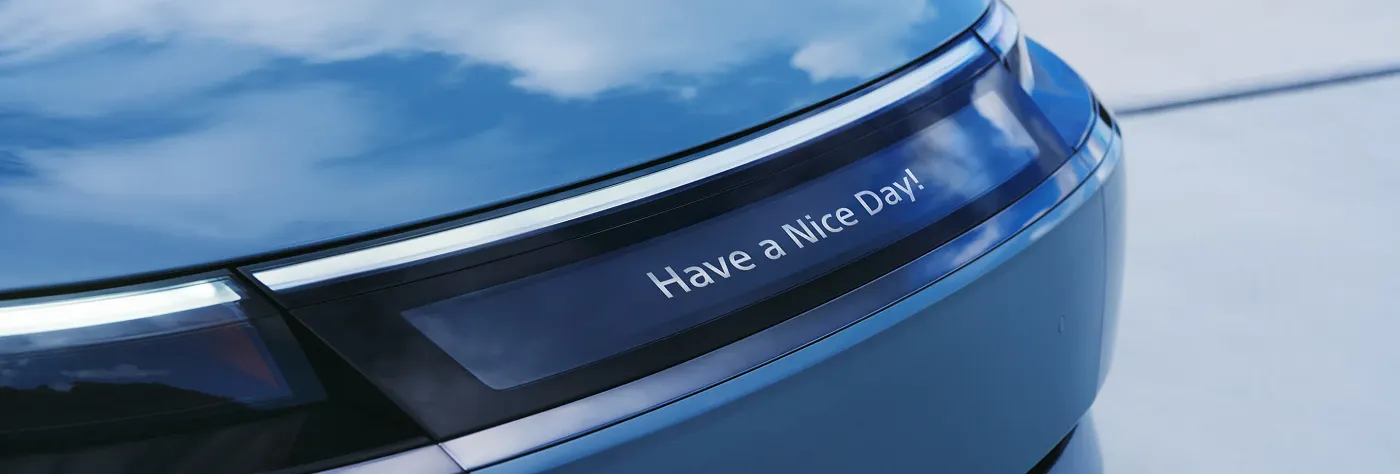Article
The Best Features Mean Nothing without a Clear Product Strategy
Field Notes Chapter One: AFEELA
August 15, 2025

A reasonable definition of a good product — digital or not — is that the whole is worth more than the sum of its parts. Last week in Los Angeles, I sat in the polar opposite: a showroom car that had some of the best features I have ever seen, yet it still left me confused.
The AFEELA, scheduled to be released in 2026, is the brainchild of Sony Honda Mobility’s recent joint venture. It is a fully-electric sedan with the latest tech you can imagine. Not only is it on the vanguard of autonomous driving, sporting long-range LiDAR that they claim outperforms Waymo, but it is also stocked to the brim with entertainment features. Some of these will be universally enjoyed, such as the Sony 360 spatial sound system, and some of these may not, like the option to enjoy your PlayStation remotely from the car. Somewhere between the two is the range of lighting displays and “moods” for the interior of the car. There’s a lot of intriguing stuff going on in the AFEELA, but intrigue matters less than congruence, and splash less than strategy.
As cars continually evolve to the point where they are effectively software on wheels, digital product strategy has become not just necessary, but central to the process of making a car.This lack of product strategy is the biggest issue with the AFEELA. Autonomous driving, relaxation, and time-passing entertainment features would make you think this car is built for roadtrips. That is until you realize that its battery has a range of “up to” 300 miles, which is less than Tesla’s Model 3 — a daily commuter.
So, is the AFEELA made for commuting? That might have been the thought behind the Media Bar , a customizable LED display on the front bumper that the showroom agent told me is “great for promotion” (this was in LA, after all) and the official website says “fosters communication between people and vehicles” and lets you “express your personality to others through digital stickers.” I was confused, too.

After all this, the store agent told me the AFEELA starts at $90,000. Who is this car for?
It’s possible that they’ve identified a target market of high-income, entertainment-loving early adopters with a penchant for public, personal branding that also have access to a large charging network and will favor the AFEELA over trusted EV competitors like Tesla, Polestar, and Lucid (all of which provide more range at lower cost). It is more likely that the engineers packed this car with as much cutting edge tech as possible with no regard for use case, synergy with adjacent features, or value to the user.
Unfortunately, a product without a unifying product strategy is hardly a product at all, rather a conglomerate of features.
Notes from Tammy Su , Product Strategist on how we might improve this product
From a product strategist’s perspective, AFEELA represents an ambitious collaboration between two globally trusted brands: Honda, known for its engineering reliability and accessible mobility offering, and Sony, a leader in entertainment, media, and digital ecosystems. It should be a win — with potential for a new category at the intersection of their strengths, between electric mobility and immersive media experience. But it’s never as easy as just putting two Lego pieces together. The true challenge is translating that potential and weaving their respective strengths into a coherent, curated and desirable product experience. In a saturated EV market, AFEELA’s success will hinge on if they can clearly answer: “For whom is this vehicle a no-brainer, and why?”, with the response serving as their product North Star. With a $90k+ luxury price point, and a wide-ranging feature set, early reactions have suggested a mismatch between what’s being offered and what consumers would actually value at that price. We’d want to take a step back to make clear consumer and market-informed tradeoffs to find that sweet spot between value and affordability, for a consumer whose needs haven’t been met yet by incumbents.
What we’re witnessing with AFEELA is a common result we see when there isn’t grounding in a clear target user or strategic opening in the category. The product will often lack focus, competing on too many fronts without really nailing it on any. This is where a product strategy team could be involved. Through even just a quick SWOT and competitive analysis, we’d aim to understand what is our right to win, and where is there space for us to do so. More robust user research would help bring a human understanding to who the potential customer may be, in conjunction with who the market research pointed to. With a more robust user target defined, grounded in real people’s experiences and needs, an ideal user journey map, along with definition of a true North Star metric could then help with the ruthless prioritization and refining of the offering down to a signature experience that’s both brand authentic and emotionally resonant.
While AFEELA has potential, potential doesn’t serve as a strategy. To win in the next EV wave, Sony and Honda need to do less, but better — starting with a core user target, and clear alignment of capabilities around an experience that hasn’t yet been done.
Thanks for reading the first installment of our field notes—stay tuned for our next feature in September!



